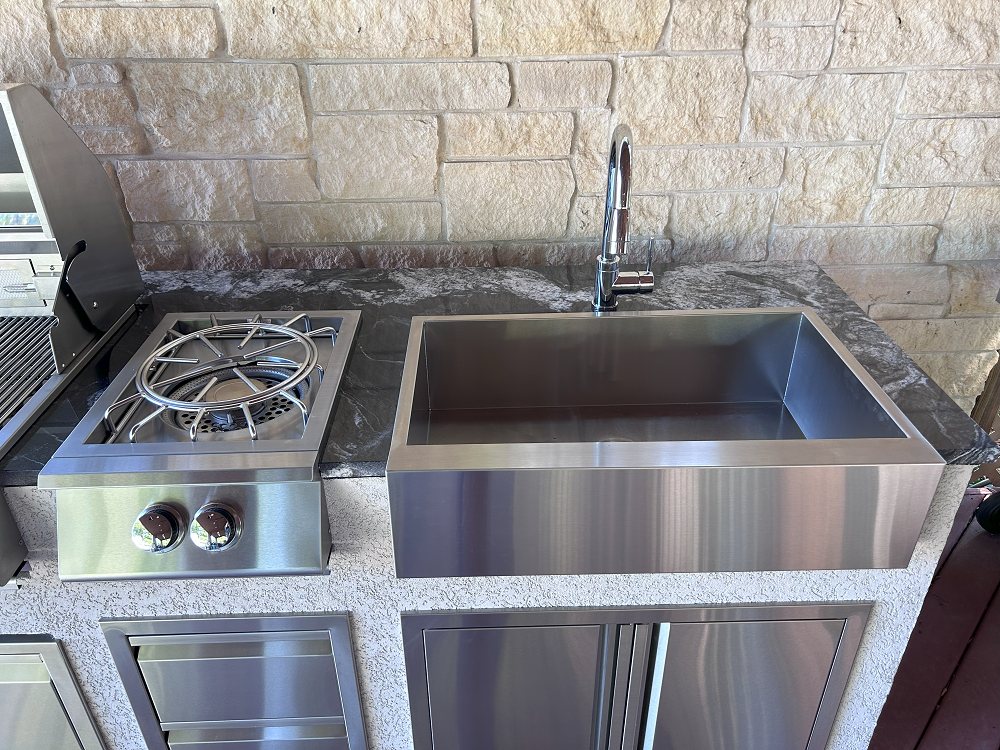How do I love thee? Let me count the ways.
If you ask us, that sonnet was probably written about outdoor sinks. It’s entirely plausible; there are a multitude of reasons to love them. Let’s count:
- First, an outdoor sink is a barbecuer’s best friend and one of the most useful components of an outdoor kitchen. It’s a practical place to prep meats and veggies before grilling, rinse salad greens, and assemble side dishes. You can use the faucet to fill pots with water for boiling corn, shrimp, crabs, lobsters, or pasta on the power burner or side burner. (It’s a pain to lug pots back and forth to the indoor kitchen, and potentially dangerous if they’re filled with scalding water.) And, of course, it’s handy for washing greasy barbecue tools, grilling accessories, plates, utensils, and serving pieces when the cookout’s done – especially if you’re storing the stuff in outdoor cabinetry afterwards.
- As part of a bar or beverage station, an outdoor sink is ideal for mixing drinks, and washing glasses, garnishes and cocktail-making gear. It can be used as a vessel to hold clean ice for filling glasses, or, double as a beverage cooler when loaded with ice and bottles of beer and wine.
- For gardeners, it’s a good place to wash hands, rinse garden veggies, clean gardening tools, make cut flower arrangements, and repot houseplants, keeping dirt and bugs outdoors.
- Crafty? An outdoor sink is a perfect arts-and-crafts clean-up station for paint brushes, glue, glitter, mud-pies, and other creative messes. And how handy would it be for tie-dye projects?!
- Got pets? An outdoor sink is practical for washing fishbowls and other pet gear – and maybe even the dog!
- Like to hunt or fish? An outdoor sink makes an efficient work station for cleaning game and the catch-of-the-day.
Outdoor Sink Specs
An outdoor sink arguably offers more utility than almost any other outdoor kitchen component. For maximum usefulness, here’s what to consider when choosing one.
Size matters. Choose as big a sink as you have room for. The 32-inch, RSNK3 Outdoor Farm House Sink from Renaissance Cooking Systems, has ample space to wash long-handled barbecue tools, large pots, and even medium dogs! At 8-inches-deep, the sink contains splashes and tall piles of plates.
Stainless steel is the most durable and practical material for an outdoor sink. It will withstand nature’s elements, won’t stain, chip or rust, and can be sanitized easily.
The RSNK3 Outdoor Farm House Sink is made of quality stainless steel, and includes a drain, strainer, and gooseneck swivel faucet with a sleek hot/cold control lever. It can accommodate a garbage disposal, has a sloped bottom for draining, and can be installed in under-mount or overhang fashion. The on-trend, farm-house-style design lends a premium, “indoor” look to any outdoor kitchen.
Siting the Sink
Just like in an indoor kitchen design, it’s best to situate an outdoor sink with at least two feet of counter space on either side, if possible. This allows room to stack dirty dishes, platters or produce on one side, and a drain board on the other.
Locating pull-out trash and recycle bins close to the sink makes it convenient to scrape plates and discard vegetable peelings. Likewise, if you’re including a dishwasher in the outdoor kitchen plan, position it next to the sink so it’s easy to load.
A cutting board is a handy complement to an outdoor sink. At 36-by-24-inches, the RCB3 Cutting Board is great for dicing, slicing and carving everything from veggies to garnishes to hot-off-the-grill meats. When not in use, the heavy-duty, black, synthetic board acts as a cover for the sink, keeping out leaves, dust and debris.
Plumbing: Hot or Not?
The simplest sink setup involves hooking it to a garden hose for the water source, and draining it into a bucket below. But, connecting the sink to your home’s plumbing and hot water supply will make it much more functional. Hot water is absolutely essential if you plan to use your sink for washing and sanitizing greasy gear that’s in contact with food. If local codes allow, draining the “graywater” (the soapy rinsewater), right into the yard through a flexible corrugated drain tube, is a pragmatic way to recycle water and aid grass growth. Likewise, graywater captured in an under-sink bucket can also be recycled to water outdoor flowers and shrubs.
Another reminder: if the outdoor sink is connected to plumbing, you’ll want to winterize it in colder climates. It’s as simple as shutting off the water to the sink and draining the line by turning on the faucet till it runs dry.
An outdoor sink can’t be beat for keeping messes out of the house, making outdoor cooking more convenient, and a multitude of other reasons to wax poetic about. For more information on the RSNK3 32-inch Outdoor Farm House Sink from Renaissance Cooking Systems click here, or visit www.rcsgasgrills.com.


